List of mammals of West Virginia


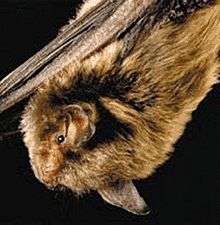
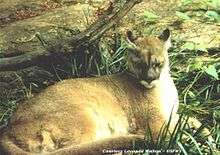
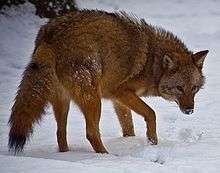
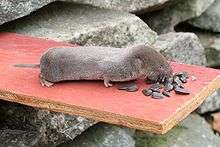
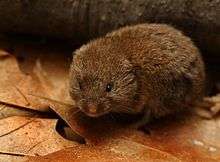

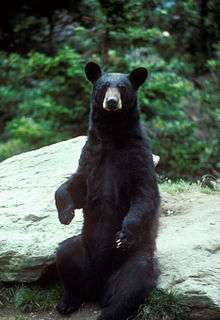
The state of West Virginia is home to 72 wild mammal species. Four – the Virginia big-eared bat, the Indiana bat, the West Virginia northern flying squirrel and the newly extinct eastern cougar – are federally listed as endangered. Several additional species are rare in the state and warrant close monitoring.
Some mammals which have thrived despite human disturbance include the opossum, which is more abundant and more widely distributed due to human activities. Also doing well are mammals that prefer farm and early successional habitats. The coyote is expanding its range eastward in the United States and now occurs throughout the state.
Many examples of West Virginia's present and former megafauna are on display at the West Virginia State Wildlife Center, a small zoo featuring native animals.
The taxa
The following letters indicate the likelihood of finding each animal in West Virginia:
| C | Common | Can be commonly seen in suitable habitat within current range. |
| U | Uncommon | Seldom seen because habitat restricted and/or behavior secretive. |
| R | Rare | Not often present even in suitable habitat. |
| E | Exotic | Not native to North America. |
| X | Extirpated | No longer present in West Virginia. |
Order Didelphimorphia (opossums)
Family Didelphidae (opossums)
- Virginia opossum (Didelphis virginiana) C
Order Soricomorpha (shrews and moles)
Family Soricidae (shrews)
- Cinereus shrew (Sorex cinereus) C
- Southeastern shrew (Sorex longirostris) U
- Smoky shrew (Sorex fumeus) U
- Long-tailed shrew (Sorex dispar) U
- American water shrew (Sorex palustris) R
- American pygmy shrew (Sorex hoyi) U
- Northern short-tailed shrew (Blarina brevicauda) C
- North American least shrew (Cryptotis parva) R
Family Talpidae (moles)
- Hairy-tailed mole (Parascalops breweri) C
- Eastern mole (Scalopus aquaticus) U
- Star-nosed mole (Condylura cristata) U
Order Chiroptera (bats)
Family Vespertilionidae (vesper bats)
- Little brown bat (Myotis lucifugus) C
- Northern long-eared bat (Myotis septentrionalis) U
- Indiana bat (Myotis sodalis) R
- Eastern small-footed myotis (Myotis leibii) R
- Gray bat (Myotis grisescens) R
- Silver-haired bat (Lasionycteris noctivagans) U
- Eastern pipistrelle (Perimyotis subflavus) C
- Big brown bat (Eptesicus fuscus) C
- Eastern red bat (Lasiurus borealis) C
- Hoary bat (Lasiurus cinereus) U
- Evening bat (Nycticeius humeralis) R
- Rafinesque's big-eared bat (Corynorhinus rafinesquii) R
- Virginia big-eared bat (Corynorhinus townsendii virginianus) R
Order Rodentia (rodents)
Family Sciuridae (squirrels)
- Eastern chipmunk (Tamias striatus) C
- Groundhog (Marmota monax) C
- Eastern gray squirrel (Sciurus carolinensis) C
- Fox squirrel (Sciurus niger) C
- American red squirrel (Tamiasciurus hudsonicus) C
- Southern flying squirrel (Glaucomys volans) C
- Virginia northern flying squirrel (Glaucomys sabrinus fuscus) R
Family Castoridae (beavers)
- North American beaver (Castor canadensis) C
Family Dipodidae (jumping mice)
- Meadow jumping mouse (Zapus hudsonius) U
- Woodland jumping mouse (Napaeozapus insignis) C
Family Cricetidae (New World mice and rats)
- Eastern harvest mouse (Reithrodontomys humulis) R
- Deer mouse (Peromyscus maniculatus) C
- White-footed mouse (Peromyscus leucopus) C
- Golden mouse (Ochrotomys nuttalli) U
- Allegheny woodrat (Neotoma magister) U
- Southern bog lemming (Synaptomys cooperi) U
- Southern red-backed vole (Myodes gapperi) C
- Meadow vole (Microtus pennsylvanicus) C
- Rock vole (Microtus chrotorrhinus) U
- Woodland vole (Microtus pinetorum) C
- Prairie vole (Microtus ochrogaster) R
- Muskrat (Ondatra zibethicus) C
Family Muridae (Old World mice and rats)
- House mouse (Mus musculus) E
- Brown rat (Rattus norvegicus) E
- Black rat (Rattus rattus) E
Family Erethizontidae (New World porcupines)
- North American porcupine (Erethizon dorsatum) R
Order Lagomorpha (rabbits, hares, and pikas)
Family Leporidae (rabbits and hares)
- Snowshoe hare (Lepus americanus) U
- Appalachian cottontail (Sylvilagus obscurus) U
- Eastern cottontail (Sylvilagus floridanus) C
Order Carnivora (carnivorans)
Family Canidae (dogs, wolves, and foxes)
- Red fox (Vulpes vulpes) C
- Gray fox (Urocyon cinereoargenteus) C
- Coyote (Canis latrans) R
- Eastern wolf (Canis lycaon) X
- Dog (Canis lupus familiaris) E
Family Ursidae (bears)
- American black bear (Ursus americanus) U
Family Procyonidae (raccoons and relatives)
- Raccoon (Procyon lotor) C
Family Mustelidae (otters, weasels, and relatives)
- Least weasel (Mustela nivalis) U
- Long-tailed weasel (Mustela frenata) U
- American mink (Neovison vison) U
- Fisher (Martes pennanti) R
- North American river otter (Lontra canadensis) R
Family Mephitidae (skunks)
- Eastern spotted skunk (Spilogale putorius) U
- Striped skunk (Mephitis mephitis) C
Family Felidae (cats)
- Bobcat (Lynx rufus) U
- Eastern cougar (Puma concolor couguar) X
- Cat (Felis catus) E
Order Artiodactyla (even-toed ungulates)
Family Suidae (pigs)
- Wild boar (Sus scrofa) E
- Domestic pig (Sus scrofa domesticus) E
Family Cervidae (deer)
- Virginia white-tailed deer (Odocoileus v. virginianus) C
- Eastern elk (Cervus c. canadensis) X
Family Bovidae (cattle, goats, and relatives)
- American bison (Bison bison) X
- Goat (Capra aegagrus hircus) E
Introduced species
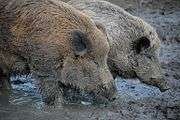
During colonial times, the black rat (roof rat), Norway rat and house mouse all came to North America, including the future West Virginia, with European settlers and traders. Dogs, cats, pigs and goats that have wandered off or were abandoned have established or feral populations in portions of the state.
Wild boar
European wild boar (Sus scrofa scrofa) were introduced into south-eastern West Virginia in 1971 (one source says “the late 1960s”) as an additional large game animal for hunting. Populations are located in the counties of Boone, Logan, Raleigh, and Wyoming. Since the late 1990s the numbers of wild boar have been decreasing, primarily due to a combination of habitat loss and food competition from the expanding populations of native black bear and whitetail deer.[2]
Recent eradications and near-eradications
Eastern timber wolf
The eastern timber wolf (Canis lupus lycaon),[3] a subspecies of the gray wolf, roamed throughout the state in pre-settlement days. Bounties were paid on their “scalps” in West Virginia through the late 1890s with the last recorded one being killed by Stofer Hamrick in Randolph County in January 1900.[4]
North American cougar
The last officially accepted wild cougar kills in both Virginia and West Virginia were in the 1880s and the animal — eastern cougar, or mountain lion, puma or panther (Puma concolor couguar) — was considered totally exterminated in West Virginia by 1900.
In 1936, however, came a last officially confirmed record of cougar tracks in the state; by a Smithsonian worker, near Cranberry Glades in Pocahontas County.[5][6][7] Recently, the eastern cougar was federally listed as "endangered" in West Virginia and sporadic, unconfirmed accounts of its presence (tracks and sightings) continued to be reported. P. c. couguar was deemed to be extirpated by a U.S. Fish and Wildlife Service evaluation released in 2011.[8]
Elk
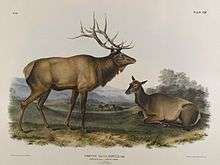
Substantial eastern elk (Cervus canadensis canadiensis) populations did not long survive the advance of white settlement into western Virginia in the late 18th and early 19th centuries. The last individual in the region around what became Doddridge County was killed by settler Winter Hutson (1814–1895) shortly after he arrived there in 1837.[9] Elk survived longest in the rugged Alleghenies to the east. In about 1843, three were killed in Canaan Valley, Virginia, by members of the Flanagan and Carr families, local settlers who habitually hunted there. These were long thought to be the last elk found wild in the region that later became West Virginia.[10] Sporadic elk sightings were again reported, however, near the headwaters of the Tygart and Greenbrier Rivers as late as 1875. If this is accurate, they were nonetheless certainly gone by 1880 when the subspecies as a whole is considered to have been completely exterminated.
The neighboring state of Kentucky actively reintroduced elk (various subspecies from Canada, Arizona, Kansas, North Dakota, New Mexico, Oregon, and Utah[11]) to their eastern woodlands in 1997, and by 2009 the population had increased to over 10,000 animals. This expanding population began to enter western Virginia and the southwestern counties of West Virginia. In 2011, the West Virginia Division of Natural Resources (WVDNR) drafted an Elk Management Plan to encourage the passive reintroduction of elk to the state.[12]
Bison
The American buffalo, or bison (Bison bison), was once common in West Virginia, roaming in large herds over the entire state. (The local subspecies has been called the eastern wood bison [Bison bison pennsylvanicus] by some experts.) Numerous place names in Pennsylvania and West Virginia attest to how frequently these animals were encountered here. In the late 18th century, white hunters and explorers in the trans-Allegheny region of the state reported seeing sizable populations especially along the Ohio and Kanawha Rivers. These herds had beaten down numerous traces or paths between salt licks. (Present day Putnam County [formed in 1848], in particular, had been cut by bison trails as the animals moved to and from the Ohio River. The county's oldest town, Buffalo, is named for them.)
Many of these paths became the Indian “roads” later used by the pioneering white settlers. Many decades later, the same bison paths would become the routes followed by early turnpikes and government road systems. Dr. Thomas Walker recorded that 13 bison were killed during his 1743 expedition of the area west of the Alleghenies. Although valued as a source of food by white settlers, many of them engaged in the wanton killing of bison as a sport. Walker noted that, "game in these parts and would have been of much greater advantage to the inhabitants than it has been if the hunters had not killed the Buffaloes for diversion."
Bison in the east were rarely seen by 1800, one was killed near Charleston in 1815, but no more were reported until 1825 when one was killed at Valley Head, the source of the Tygart River in Randolph County. It had been chased from Webster County by dogs.[10] If the "eastern wood bison" is a legitimate subspecies (it is disputed), this individual may have been the last one in existence.
Virginia (southern) white-tail deer
This subspecies (Odocoileus virginianus virginianus) of white-tail deer originally ranged over all of West Virginia, but was nearly exterminated within the state due to over-hunting. By 1890, the white-tail deer population of West Virginia was officially reported as “near zero”.[13]
As hunting regulations were enacted, law enforcement personnel hired, game refuges established and restocking started, the deer population gradually was reestablished. In January 1930, eight deer procured from Michigan were released in the Monongahela National Forest near Parsons. Between 1937 and 1939, a total of 17 more deer were released in the Flatrock-Roaring Plains area of Tucker County (DeGarmo 1949). These 25 deer are the only recorded deer releases in Tucker County.[14] Today, this animal is prolific throughout the state.
Beaver
North American beaver (Castor canadensis) were almost completely exterminated from the area now known as West Virginia by 1825 due to trapping by early settlers (Swank 1948). The gradual comeback of beaver started in 1933 when 6 beaver were released on Beaver Dam Refuge in Randolph County. In 1935, 40 animals were released with ten placed in Tucker County.[15][16]
Fisher
There were reports of the fisher (Martes pennanti) — also known as Pennant’s marten — being trapped in West Virginia and pelts being sold in the 1870s. They were rare in West Virginia by around 1900, with the last reports coming from the high elevation red spruce forests. By 1912, however, the animals were believed to be rare or completely extirpated. They were reintroduced to the state in the winter of 1969, when twenty-three fishers were translocated from New Hampshire to two sites within the boundaries of the Monongahela National Forest at Canaan Mountain in Tucker County and Cranberry Glades in Pocahontas County.
River otter
The North American river otter (Lontra canadensis) is a native species in West Virginia but its population declined due to loss of habitat and excessive trapping. The last otter was reported to have been trapped in Tucker County in 1954; then a few were seen on the Greenbrier River in Pocahantas County and elsewhere in the early 1960s.[17] In a restoration effort, a total of 245 river otters were released by the WVDNR into 14 major river systems in West Virginia between 1984 and early 1997[18] Based on otter sightings, sign and trap mortalities, the river otter is known to be successfully reestablished in the state.
Threatened species
According to the International Union for Conservation of Nature (IUCN), 5 mammal species in West Virginia are threatened with extinction.
Indiana bat
The Indiana bat is classified as near threatened. This bat forages in forested areas alongside rivers and streams, gives birth under loose bark or in the cavities of dead trees, and prefers to hibernate in limestone caves with pools. Mortality due to white nose syndrome, a fungal infection that has killed millions of bats throughout the eastern United States, remains one of this bat's most significant threats.[19] Other major threats include the human disturbance of its winter hibernacula, vandalism of caves and the deliberate killing of roosting bats, and loss of summer habitat due to stream channelization, housing development, and clearcutting. Conservation efforts include the protection of summer and winter caves and the proper management of forests to reduce the loss of summer habitat.[20]
Gray bat
The gray bat is classified as near threatened. This bat forages along the forested edges of streams and rivers and prefers to roost in deep, vertical caves. It is threatened due to cave disturbance, pesticides and herbicides, and deforestation. Conservation efforts for this species include the protection of roosting caves and the restriction of pesticide and herbicide use around cave entrances.[21]
Allegheny woodrat
The Allegheny woodrat is classified as near threatened. It prefers areas with rocky sandstone cliffs, especially near caves and rocky outcrops with deep crevices. Threats include deforestation, parasitism by the raccoon roundworm, increased oak mortality due to gypsy moth infestation, and strip mining for coal and limestone. Conservation efforts include the restriction of mining, logging, and destructive recreational activities in areas with suitable woodrat habitat.[22]
Appalachian cottontail
The Appalachian cottontail is classified as near threatened. This rabbit is similar to the eastern cottontail, but is much rarer. Unlike the eastern cottontail, which thrives in many different habitat types, the Appalachian cottontail prefers conifer forests at high elevations. Threats include the deforestation of habitat due to urban development, competition with the eastern cottontail, and hunting mortality (hunters can easily mistake this rabbit for the more numerous eastern cottontail). Conservation efforts include the protection of suitable habitat and the education of hunters on the differences between the eastern and the Appalachian cottontails.[23]
Eastern spotted skunk
The eastern spotted skunk is classified as vulnerable. In West Virginia, this skunk lives in forested areas at higher elevations. Threats are not known; they may include accidental trapping by fur trappers, the increased use of synthetic pesticides, habitat destruction, changes in predator communities, and various diseases, including parvoviruses, rabies, and distemper. Conservation efforts include researching the possible factors behind this species' decline. [24]
Ice Age (Pleistocene) mammals of West Virginia[25]
- Fossil site(s) indicated in parentheses.
Megafauna:
- Megalonyx jeffersonii, or Jefferson's ground sloth (first found in 1796 in Haynes Cave, Monroe County)
- Mammuthus spp, mammoths, including the wooly mammoth (M. primigenius); 12 specimens known in state
- Mammut americanum, American mastodon
- Bootherium bombifrons, Harlan's (or woodland) muskox (Brooke County)
- Rangifer tarandus, caribou
- Platygonus vetus, peccary
- Smilodon spp, saber-toothed cat (Greenbrier and Pendleton Counties)
- Miracinonyx inexpectatus, a cheetah
- Panthera onca augusta, Pleistocene North American jaguar (Pendleton County)
- Canis dirus, dire wolf
- Arctodus pristinus, a giant bear
- A Pleistocene tapir
Small mammals:
- Dasypus bellus, a Pleistocene armadillo (first found in the state in Organ Cave, Greenbrier County; now also known from Berkeley County (1995))

- Desmodus spp, a vampire bat
- Sorex arcticus, Arctic shrew
- Synaptomys borealis, northern bog lemming
- Atopomys salvelinus, Trout Cave vole (Trout Cave, Pendleton County, etc.)
- Plesiothomomys spp, Cumberland Cave pocket gopher (first found in Cumberland Bone Cave)
- Pitymys cumberlandensis, Cumberland Cave vole
- Peromyscus cumberlandensis, Cumberland Cave mouse
See also
- Lists of mammals by region
- West Virginia State Wildlife Center, a small zoo featuring native West Virginia animals
- Fauna of West Virginia
- List of West Virginia wildlife management areas
References
Citations
- ↑ "State Symbols". West Virginia Legislature. Retrieved 2011-09-02.. Selected as West Virginia's official State Animal by a poll of students, teachers and sportsmen conducted by the WV Division of Natural Resources in 1954-1955. It was officially adopted by the State Legislature during the 1973 Regular Session with the approval of House Concurrent Resolution 6.
- ↑ "Big Game Bulletin - 2010" (PDF). West Virginia Department of Natural Resources. p. 21. Retrieved 2011-08-01.
- ↑ “Efforts to restore wolves to the northeastern United States have been confounded by a new taxonomic proposal: that the wolf historically inhabiting this region was not, as previously thought, a subspecies of gray wolf commonly called the eastern timber wolf (Canis lupus lycaon), but rather a separate species closely related to the red wolf (Canis rufus) of the southeast United States. This hypothesis raises numerous biological, legal, policy, and management questions about potential wolf restoration.” From: Fascione Nina, Lisa G.L. Osborn, Stephen R. Kendrot, and Paul C. Paquet (July/August 2001), “Canis soupus: eastern wolf genetics and its implications for wolf recovery in the Northeast United States” on BNET.
- ↑ Brooks, Fred E. (1911), "The Mammals of West Virginia", W. Va. State Bd. of Agr. Quarterly Report; 20; 9-30.
- ↑ Deurbrouck, Jo (2007), Stalked by a Mountain Lion: Fear, Fact, and the Uncertain Future of Cougars in America, Globe Pequot, pg 93.
- ↑ Kellog, Remington (1937), ‘’Annotated list of West Virginia Mammals’’, Proc. U.S. Nat. Museum, 84:443-479.
- ↑ This does not include an incident in the 1960s or ‘70s in Pocahontas County: According to WVDNR District Biologist Ray Knotts, two mountain lions were sighted. One was killed and one was captured. It was determined that the two large cats were “quite friendly” and had been raised in captivity.
- ↑ USF&WS (March 2, 2011), “U.S. Fish and Wildlife Service Concludes Eastern Cougar Extinct” [Press release].
- ↑ Compton, Mildreth Hutson, "Trails of Our Hutson Heritage", In: Hutson, Rex (1996), John Hutson and Some Descendants, Delaware, Ohio: Mid-Ohio Printing, pg 22.
- 1 2 Maxwell, Hu (1898). The History of Randolph County, West Virginia, From its Earliest Settlement to the Present, The Acme Publishing Company, Morgantown, W.Va. (Reprinted, McClain Printing Company, Parsons, W.Va., 1961). p. 300.
- ↑ "Elk Restoration and Management Options for Southwest Virginia" (PDF). Virginia Department of Game and Inland Fisheries. 2010. p. 45. Retrieved 2011-08-01.
- ↑ "Draft: West Virginia Elk Management Plan, 2011-2015" (PDF). West Virginia Department of Natural Resources. Retrieved 2011-07-31.
- ↑ Trefethen, James B., “The Return of the White-tailed Deer”; American Heritage, February 1970; Volume 21, Issue 2.
- ↑ Lesser, Walter A. and Jack I. Cromer, Unpublished MS: Historical Review of Wildlife Management in Canaan Valley and Surrounding Area, West Virginia Division of Natural Resources.
- ↑ Lesser and Cromer, Op. cit.
- ↑ Swank, W. A. 1948. Beaver Ecology and Management in West Virginia. Final Report P-R Project W-16-R. Conservation Commission of West Virginia, Charleston, West Virginia. 70 pp.
- ↑ Clarkson, Roy B. (1964), Tumult on the Mountains: Lumbering in West Virginia 1770-1920; Line drawings by William A. Lunk; Parsons, West Virginia; McClain Printing Company, pg 12.
- ↑ Allen, T. J. 1997. River Otter Translocation and Status. Final Report, P-R Project W-48-R-13. West Virginia Division of Natural Resources. Charleston, West Virginia. 10pp.
- ↑ Froschauer, Ann; Coleman, Jeremy (17 January 2012). "North American bat death toll exceeds 5.5 million from white-nose syndrome" (PDF). White-Nose syndrome.org. U.S. Fish & Wildlife Service. Retrieved 2012-02-03.
- ↑ Arroyo-Cabrales, J. & Álvarez-Castañeda, S.T. 2008. Myotis sodalis. The IUCN Red List of Threatened Species. Version 2015.2. <www.iucnredlist.org>. Downloaded on 30 July 2015.
- ↑ Arroyo-Cabrales, J. & Timm, R. 2008. Myotis grisescens. The IUCN Red List of Threatened Species. Version 2015.2. <www.iucnredlist.org>. Downloaded on 30 July 2015.
- ↑ Linzey, A.V. & NatureServe (Hammerson, G., Whittaker, J.C. & Norris, S.J.) 2008. Neotoma magister. The IUCN Red List of Threatened Species. Version 2015.2. <www.iucnredlist.org>. Downloaded on 30 July 2015.
- ↑ Barry, R. & Lazell, J. 2008. Sylvilagus obscurus. The IUCN Red List of Threatened Species. Version 2015.2. <www.iucnredlist.org>. Downloaded on 30 July 2015.
- ↑ Gompper, M. & Jachowski, D. 2016. Spilogale putorius. The IUCN Red List of Threatened Species 2016: e.T41636A45211474. http://dx.doi.org/10.2305/IUCN.UK.2016-1.RLTS.T41636A45211474.en. Downloaded on 18 October 2016.
- ↑ Garton, E. Ray (2012), “Fauna of the Ice Age”, Wonderful West Virginia, pp 11-13 (January issue).
Other sources
- Mammals of West Virginia: A Field Checklist (2001); West Virginia Division of Natural Resources, Wildlife Resources Section; Accessed 18 September 2010.